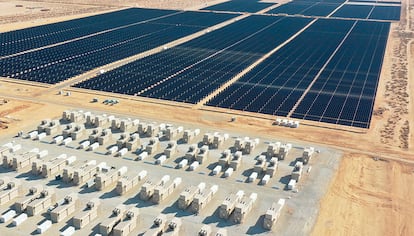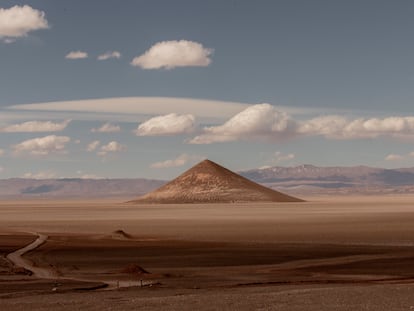Batteries start to rival gas on California’s electricity grid
America’s most populous state aims to use 100% clean energy by 2045, thanks to storage boom


At the gates of the Mojave Desert, there is a vast black ocean consisting of more than 1.9 million solar panels. This gigafactory began operating at the beginning of this year and has become one of the most recent additions to the electricity grid in California, the state that leads the U.S. in the race for clean energy. Operated by Minnesota company, Mortenson, the facility has a storage capacity of 3,280 megawatts in 120,000 installed batteries. This makes it the only one in the country with this degree of autonomy, which is key to the ambitious goal that local authorities have set for 2045, when the state will rely on 100% renewable energy.
California achieved an important milestone in the fight against climate change at the end of April. At that time, Governor Gavin Newsom announced that the region had surpassed 10,000 megawatts of photovoltaic storage for the first time ever, enough to meet 20% of demand. “In just five years, California has increased its battery storage capacity more than tenfold,” Newsom said. When he came to power in 2019, the state had a storage capacity of 770 megawatts. To reach the goals set for 2045, California needs to build a storage network of 52,000 megawatts.
Progress in the nation’s most populous state is staggering. Mark Rothleder, the vice president of the independent grid operator, California ISO (CAISO), said earlier this year that they will add another 1,134 megawatts in the first eight months of 2024. This is growth on top of the leap made last year. “In 2023 alone, the ISO successfully onboarded 5,660 megawatts of new power to the grid,” Rothleder said at a conference in San Diego.
Strengths
Rothleder also flagged up the growing number of lithium batteries as the system’s main strength: “[It’s] an impressive California success story because, despite an occasional glitch, the four-hour batteries have performed very well, and we have been able to dispatch this stored power for the net peak evening hours in the day when it’s most needed,” he said. Currently, the high cost of batteries is one of the main obstacles preventing this technology from becoming more popular. Experts say that if prices came down, battery life could be extended to eight to 10 hours.
The mild climate of 2023, the wettest year for a region known for persistent drought and numerous wildfires, has been key to the advancement of the renewable grid. Last summer was the first in four that the regulator did not issue a public alert asking people to turn off appliances and save energy to ensure that demand did not outstrip supply. In the previous three years, 29 such alerts had been issued.
The spring of 2024 has also helped California record more clean energy milestones. Mild temperatures kept demand low as people used their air conditioners less. After sunset, energy stored in batteries was used with gas entering the system to supplement demand. Renewable production was enough to supply the grid on 40 out of 48 days this spring, compared to seven days in the whole of last year.
Lithium batteries appear to be undercutting the use of fossil fuels. Gas accounts for 40% of California’s grid. However, its use in April registered its lowest proportion in seven years. “The data clearly shows that batteries are displacing natural gas when solar generation is ramping up and down each day in CAISO,” notes an analysis by Grid Status, a firm specializing in energy issues.
Natural gas was king on the grid in April 2021, 2022 and 2023. CAISO was sending between 9,000 and 10,000 megawatts produced from gas to the grid once solar ran out. Last April, however, it amounted to only 5,000 megawatts. On April 30, a fleet of batteries went into action around 6 p.m. and were active until midnight. At around 8 p.m., during the peak demand period, lithium contributed 7,000 megawatts. This is similar to the megawatts produced by gas around that hour of the day.
Arizona and Georgia have followed California’s lead. But it is Texas, the other major U.S. giant in this industry, that is snapping at its heels. At the end of April, batteries supplied 4% of the grid’s electricity, enough to power several million homes. Batteries are beginning to look like an alternative to a system heavily dependent on gas and coal. The grid is facing increasing climatic challenges, such as very low temperatures in winter and extreme heat in summer.
Sign up for our weekly newsletter to get more English-language news coverage from EL PAÍS USA Edition
Tu suscripción se está usando en otro dispositivo
¿Quieres añadir otro usuario a tu suscripción?
Si continúas leyendo en este dispositivo, no se podrá leer en el otro.
FlechaTu suscripción se está usando en otro dispositivo y solo puedes acceder a EL PAÍS desde un dispositivo a la vez.
Si quieres compartir tu cuenta, cambia tu suscripción a la modalidad Premium, así podrás añadir otro usuario. Cada uno accederá con su propia cuenta de email, lo que os permitirá personalizar vuestra experiencia en EL PAÍS.
¿Tienes una suscripción de empresa? Accede aquí para contratar más cuentas.
En el caso de no saber quién está usando tu cuenta, te recomendamos cambiar tu contraseña aquí.
Si decides continuar compartiendo tu cuenta, este mensaje se mostrará en tu dispositivo y en el de la otra persona que está usando tu cuenta de forma indefinida, afectando a tu experiencia de lectura. Puedes consultar aquí los términos y condiciones de la suscripción digital.
More information

The battle for lithium: US and China fight over Argentina’s white gold
Archived In
Últimas noticias
Most viewed
- Sinaloa Cartel war is taking its toll on Los Chapitos
- Oona Chaplin: ‘I told James Cameron that I was living in a treehouse and starting a permaculture project with a friend’
- Reinhard Genzel, Nobel laureate in physics: ‘One-minute videos will never give you the truth’
- Why the price of coffee has skyrocketed: from Brazilian plantations to specialty coffee houses
- Silver prices are going crazy: This is what’s fueling the rally









































